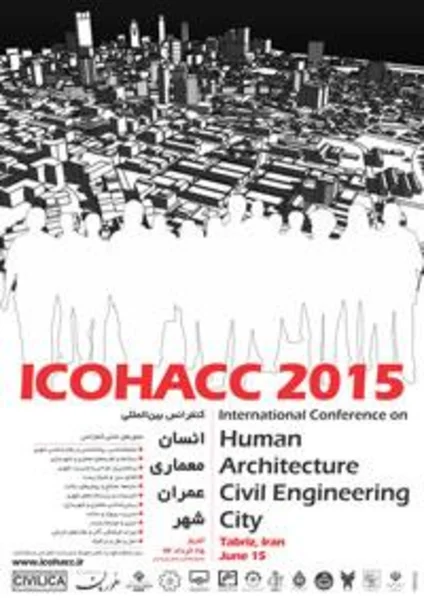-
smart building materials for remove of voc pollutants from environment (indoor/outdoor)
جزئیات بیشتر مقاله- تاریخ ارائه: 1394/01/01
- تاریخ انتشار در تی پی بین: 1394/01/01
- تعداد بازدید: 612
- تعداد پرسش و پاسخ ها: 0
- شماره تماس دبیرخانه رویداد: -
this paper was focused on the surrounding design of environmentally responsible buildings. the design of the building envelope and the building fabric will affect the comfort conditions and depollution of environment (indoor/outdoor). external building surfaces (i.e. tiles, ceramic, glass, and so on), are ideal places to be modified with photocatalysts to get an additional depollution function due to availability of sunlight. the innovative technology is dedicated to decompose gaseous pollutants using photocatalysts under illumination of uv or solar light without extra energy added. heterogeneous photocatalytic oxidation (pco) is one of the most active research areas in environmental indoor/outdoor air purification. a number of studies focused on the application of tio2 modified building materials and components, such as paints, wall paper, tile, and windows. for the technology of air-cleaning building materials or concrete pavement, various gaseous contaminants, including nox, volatile organic compounds (voc), and so on, as well as particulate matter, such as carbon soot, have been tested as challenge contaminants to examine the photocatalytic degradation performance. the objective of this study is the generation of metal oxide coupled with tio2 photocatalysts (transition metal mixed oxides /tio2) that exhibit enhanced photocatalytic activity compared to the non-modified one on the commercial surfaces such as tiles, glasses and stones. in this experimental work, various scales and other related research, such as coating techniques, and testing methods, are discussed and evaluated separately for pco air cleaners on the different building materials such as tile, glass and stones. samples were prepared with sol-gel and dip-coating methods. it was found that coating techniques affected the performance of photocatalytic activity. the voc photocatalytic degradation was obtained utilizing flat plate samples in a cylindrical photo reactor. different light source was used. the inlet gas was a mixture of air with volatile organic compound such as toluene and soot. the concentration of the outlet gas was measured using a gas chromatography analyzer (gc shimadzu 2020). the photocatalytic activity of the plates was conducted in a reactor described in detail in the paper. the surface area of irradiated samples was kept constant. additions of ag- tio2/mixed oxides photocatalyst to building materials results in the abatement of pollutants found in air, and self-cleaning effects avoiding the soot and organic materials attached to the building surface. conversion efficiencies of voc depollution of above 30-60% for different surface were observed. the coated stone, tile and glasses with different additives, characterized by the aid of fesem, x-ray diffraction analysis to study the structure and morphology of the tested samples.
مقالات جدیدترین رویدادها
-
استفاده از تحلیل اهمیت-عملکرد در ارائه الگوی مدیریت خلاقیت سازمانی و ارائه راهکار جهت بهبود
-
بررسی تاثیر ارزش وجوه نقد مازاد بر ساختار سرمایه شرکت های پذیرفته شده در بورس اوراق بهادار تهران
-
بررسی تأثیر سطح افشای ریسک بر قرارداد بدهی شرکت های پذیرفته شده در بورس اوراق بهادار تهران
-
بررسی تأثیر رتبه بندی اعتباری مبتنی بر مدل امتیاز بازار نوظهور بر نقد شوندگی سهام با تأکید بر خصوصی سازی شرکت ها
-
تأثیر آمیخته بازاریابی پوشاک ایرانی بر تصویر ذهنی مشتری پوشاک ایرانی (هاکوپیان)
-
بررسی پترولوژیکی و ژئوشیمیایی سنگ های ولکانیکی میوسن شمال خروانق - شرق دستجرد
-
استخراج تایمینگ متغیر بهینه برای موتور چهارسیلندر xu7
-
یک الگوریتم جدید موازی جستجوی اول سطح با استفاده از پردازنده گرافیکی
-
بررسی عملکرد یک موتور اشتعال تراکمی مخلوط همگن با سوخت هیدروژن
-
the impact of online teaching on esl student’s academic grammar proficiency during post-covid
مقالات جدیدترین ژورنال ها
-
مدیریت و بررسی افسردگی دانش آموزان دختر مقطع متوسطه دوم در دروان کرونا در شهرستان دزفول
-
مدیریت و بررسی خرد سیاسی در اندیشه ی فردوسی در ادب ایران
-
واکاوی و مدیریت توصیفی قلمدان(جاکلیدی)ضریح در موزه آستان قدس رضوی
-
بررسی تاثیر خلاقیت، دانش و انگیزه کارکنان بر پیشنهادات نوآورانه کارکنان ( مورد مطالعه: هتل های 3 و 4 ستاره استان کرمان)
-
بررسی تاثیر کیفیت سیستم های اطلاعاتی بر تصمیم گیری موفق در شرکتهای تولیدی استان اصفهان (مورد مطالعه: مدیران شرکتهای تولیدی استان اصفهان)
-
مطالعه تطبیقی نفقه زوجه در آموزه های قرآن کریم و قانون مدنی افغانستان
-
واکاوی تجارب زیسته مدیران آموزشی از چالش ها و موانع توسعه صلاحیت حرفه ای
-
سیره اقتصادی امام علی (علیه السلام) در الگوی تولید و مصرف مدبرانه
-
راهکارهای درمان پرخاشگری از دیدگاه قرآن و روایات
-
the impact of resistance economic policies on the reduction of cases that have been rejected and the tax gap in businesses




سوال خود را در مورد این مقاله مطرح نمایید :